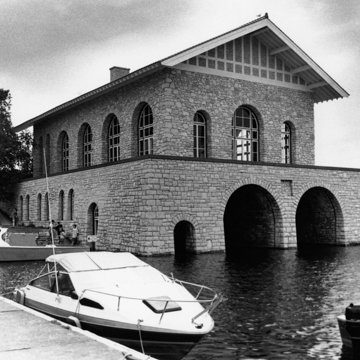Today Rock Island is a public park, but initially it was the private retreat of millionaire electrical inventor and manufacturer Chester Hjortur Thordarson. Perhaps his heritage brought him to Rock Island, for Thordarson was an Icelandic immigrant, and nearby Washington Island was home to the nation’s oldest Icelandic settlement.
Like many industrialists of his day, Thordarson worked and made his fortune in the city—Chicago, in his case—but felt a strong pull to nature. Originally he planned to keep the island a forest preserve, but in the 1920s he began a 777-acre vacation complex to emulate those of other wealthy men and to evoke a romanticized Icelandic landscape. Charming outbuildings include a stone picnic pavilion (c. 1925) with flaring pagoda roof covered in tiles, a coursed cobblestone greenhouse (c. 1925), and a guesthouse (1926). This last was designed by Frederick Dinkelberg of Chicago and executed in irregularly coursed limestone. Dinkelberg also designed in 1926 the imposing eclectic boathouse-casino. Boats can drift in and out of round-arched portals. The boathouse roof forms a generous deck around the casino, from which rises the second story. Its rustic limestone-rubble walls, large arched windows, and false half-timbered gable with wide overhanging eaves create a picturesque effect. Inside, the casino’s grand hall boasts coursed cobble walls and a massive, crenellated fieldstone fireplace. Set in the hearth, a wooden plaque written in archaic English exhorts visitors to be moderate in mirth. A chandelier made of antlers suggests festive Nordic hunt celebrations. Huge tables and chairs engraved with Icelandic verse originally furnished the room.
Most of Thordarson’s complex clusters on the western shore of Rock Island, but visitors can follow a mile-long path to the eastern shore, where a dramatic water tower (c. 1929) overlooks Lake Michigan. At the north tip of the island stands the Pottawatomie Lighthouse (1836), which was restored in 2005 by the Friends of Rock Island Lighthouse.


